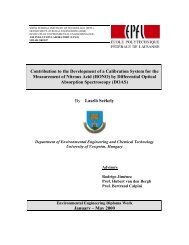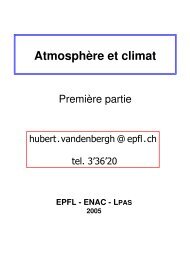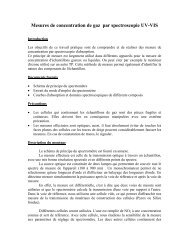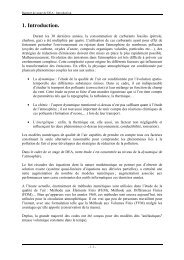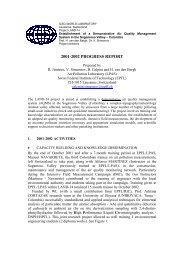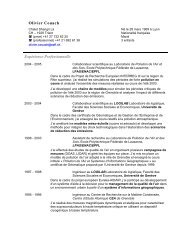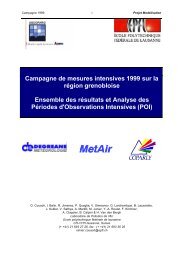Diploma report Implementation and verification of a simple ... - LPAS
Diploma report Implementation and verification of a simple ... - LPAS
Diploma report Implementation and verification of a simple ... - LPAS
You also want an ePaper? Increase the reach of your titles
YUMPU automatically turns print PDFs into web optimized ePapers that Google loves.
have<br />
∫<br />
d z2<br />
∫ x2<br />
ρ(x, z, t)dxdz = F 1 (z, t) − F 2 (z, t) + G 1 (x, t) − G 2 (x, t), (6)<br />
dt z 1 x 1<br />
where F i (z, t) are the flux functions at the lateral boundaries x i , i = 1, 2, <strong>and</strong> G i (x, t) the<br />
fluxes at the top <strong>and</strong> bottom boundaries z i , i = 1, 2. Note that F 1 (z, t) corresponds to the<br />
flux to the right <strong>and</strong> −F 2 (z, t) represents the flux to the left.<br />
Equation (6) represents the integral from <strong>of</strong> a conservation law for the mass <strong>and</strong> the<br />
flux functions are to be related to ρ(x, z, t) in order to obtain an equation that might be<br />
solvable for ρ. The mass flux through boundary x i is associated with the mass transported<br />
with velocity u through x i so that F is given by ρu. Similarly, G is given by ρw. The integral<br />
form <strong>of</strong> the conservation law becomes then<br />
d<br />
dt<br />
∫ z2<br />
∫ x2<br />
z 1<br />
x 1<br />
ρ(x, z, t)dxdz = −ρu∣ x 2<br />
− ρw∣ z 2<br />
. (7)<br />
x 1 z 1<br />
Assuming that ρ, u <strong>and</strong> w are smooth functions, the integral form <strong>of</strong> the conservation law can<br />
be transformed into a partial differential equation (see appendix A). The differential form <strong>of</strong><br />
the conservation law for ρ is then<br />
ρ t + (ρu) x + (ρw) z = 0. (8)<br />
This equation called the continuity equation models the conservation <strong>of</strong> mass.<br />
In addition to ρ(x, z, t), the velocity components u(x, z, t) <strong>and</strong> w(x, z, t) are also to be determined<br />
<strong>and</strong> two equations are needed for this. The velocities themselves are not conserved<br />
quantities, but the x-momentum ρu <strong>and</strong> the z-momentum ρw are. Each <strong>of</strong> these momenta<br />
are transported with the flow <strong>and</strong>, by analogy with the density flux in (8), this will give<br />
contributions <strong>of</strong> ((ρu)u) x + ((ρu)w) z <strong>and</strong> ((ρw)u) x + ((ρw)w) z to the x- <strong>and</strong> z-momentum<br />
respectively. Beside this, there are additional microscopic terms for the momentum fluxes<br />
that are due to the pressure in the fluid. These microscopic fluxes are caused by the fact that<br />
all nearby molecules are not moving at the same speed in a gas. Pressure variation in the<br />
x-direction, measured by p x appears in the equation for ρu, while p z appears in the equation<br />
for ρw.<br />
In the vertical direction, there are external gravity forces acting on the gas that accelerate<br />
downward individual molecules. These forces must be integrated over the domain<br />
<strong>and</strong> this contribution added to the integral conservation law for z-momentum (if z is aligned<br />
with the gravitational acceleration). Thus the differential form <strong>of</strong> the z-momentum equation<br />
will contain a source term <strong>of</strong> s = −ρ∇Φ, where Φ = gz is the gravitational potential.<br />
The differential forms <strong>of</strong> the conservation laws for momentum are then<br />
(ρu) t + (ρu 2 + p) x + (ρuw) z = 0, (9)<br />
(ρw) t + (ρwu) x + (ρw 2 + p) z = −ρ∇Φ. (10)<br />
6



